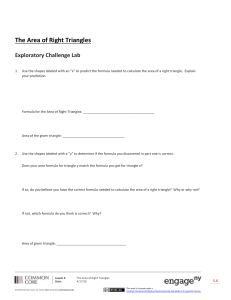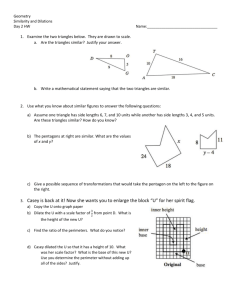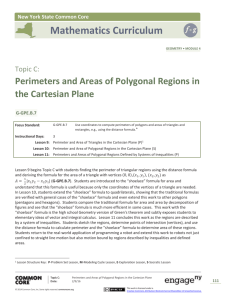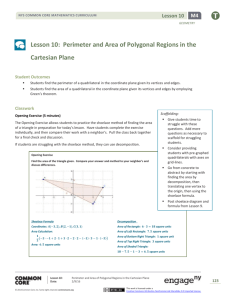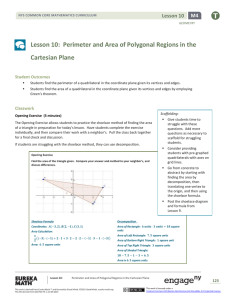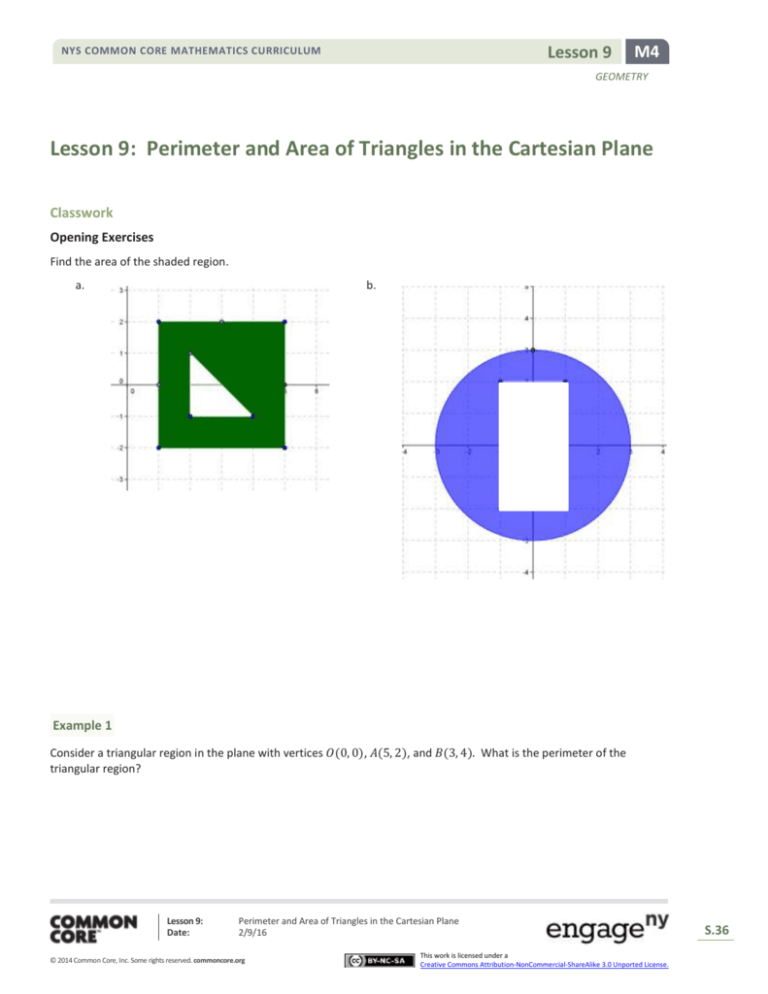
Lesson 9
NYS COMMON CORE MATHEMATICS CURRICULUM
M4
GEOMETRY
Lesson 9: Perimeter and Area of Triangles in the Cartesian Plane
Classwork
Opening Exercises
Find the area of the shaded region.
a.
b.
Example 1
Consider a triangular region in the plane with vertices 𝑂(0, 0), 𝐴(5, 2), and 𝐵(3, 4). What is the perimeter of the
triangular region?
Lesson 9:
Date:
Perimeter and Area of Triangles in the Cartesian Plane
2/9/16
© 2014 Common Core, Inc. Some rights reserved. commoncore.org
This work is licensed under a
Creative Commons Attribution-NonCommercial-ShareAlike 3.0 Unported License.
S.36
Lesson 9
NYS COMMON CORE MATHEMATICS CURRICULUM
M4
GEOMETRY
What is the area of the triangular region?
Find the general formula for the area of the triangle with vertices 𝑂(0, 0), 𝐴(𝑥1 , 𝑦1 ), and 𝐵(𝑥2 , 𝑦2 ) as shown.
Does the formula work for this triangle?
Lesson 9:
Date:
Perimeter and Area of Triangles in the Cartesian Plane
2/9/16
© 2014 Common Core, Inc. Some rights reserved. commoncore.org
This work is licensed under a
Creative Commons Attribution-NonCommercial-ShareAlike 3.0 Unported License.
S.37
Lesson 9
NYS COMMON CORE MATHEMATICS CURRICULUM
M4
GEOMETRY
Exercise 1
Find the area of the triangles with vertices listed, first by finding the area of the rectangle enclosing the triangle and
1
subtracting the area of the surrounding triangles, then by using the formula (𝑥1 𝑦2 − 𝑥2 𝑦1 ).
2
a.
𝑂(0, 0), 𝐴(5, 6), 𝐵(4, 1)
b.
𝑂(0, 0), 𝐴(3, 2), 𝐵 (−2, 6)
c.
𝑂(0, 0), 𝐴(5, −3), 𝐵(−2, 6)
Lesson 9:
Date:
Perimeter and Area of Triangles in the Cartesian Plane
2/9/16
© 2014 Common Core, Inc. Some rights reserved. commoncore.org
This work is licensed under a
Creative Commons Attribution-NonCommercial-ShareAlike 3.0 Unported License.
S.38
Lesson 9
NYS COMMON CORE MATHEMATICS CURRICULUM
M4
GEOMETRY
Problem Set
1.
Use coordinates to compute the perimeter and area of each polygon.
a.
2.
b.
Given the figures below, find the area by decomposing into rectangles and triangles.
a.
b.
Lesson 9:
Date:
Perimeter and Area of Triangles in the Cartesian Plane
2/9/16
© 2014 Common Core, Inc. Some rights reserved. commoncore.org
This work is licensed under a
Creative Commons Attribution-NonCommercial-ShareAlike 3.0 Unported License.
S.39
Lesson 9
NYS COMMON CORE MATHEMATICS CURRICULUM
M4
GEOMETRY
3.
Challenge: Find the area by decomposing the given figure into triangles.
4.
When using the shoelace formula to work out the area of △ 𝐴𝐵𝐶, we
have some choices to make. For example, we can start at any one of
the three vertices 𝐴, 𝐵, or 𝐶, and we can move either in a clockwise or
counterclockwise direction. This gives six options for evaluating the
formula.
Show that the shoelace formula obtained is identical for the three
options that move in a clockwise direction (𝐴 to 𝐶 to 𝐵 or 𝐶 to 𝐵 to 𝐴
or 𝐵 to 𝐴 to 𝐶) and identical for the three options in the reverse
direction. Verify that the two distinct formulas obtained differ only by
a minus sign.
5.
6.
Suppose two triangles share a common edge. By translating and rotating the
triangles, we can assume that the common edge lies along the 𝑥-axis with one
endpoint at the origin.
a.
Show that if we evaluate the shoelace formula for each triangle, both
calculated in the same clockwise direction, then the answers are both
negative.
b.
Show that if we evaluate them both in a counter-clockwise direction, then
both are positive.
c.
Explain why evaluating one in one direction and the second in the opposite
direction, the two values obtained are opposite in sign.
A textbook has a picture of a triangle with vertices (3, 6) and (5, 2). Something happened in printing the book and
the coordinates of the third vertex are listed as (−1, ). The answers in the back of the book give the area of the
triangle as 6 square units.
a.
What is the 𝑦-coordinate of the third vertex?
b.
What if both coordinates were missing, but the area was known. Could you use algebra to find the third
coordinate? Explain.
Lesson 9:
Date:
Perimeter and Area of Triangles in the Cartesian Plane
2/9/16
© 2014 Common Core, Inc. Some rights reserved. commoncore.org
This work is licensed under a
Creative Commons Attribution-NonCommercial-ShareAlike 3.0 Unported License.
S.40

